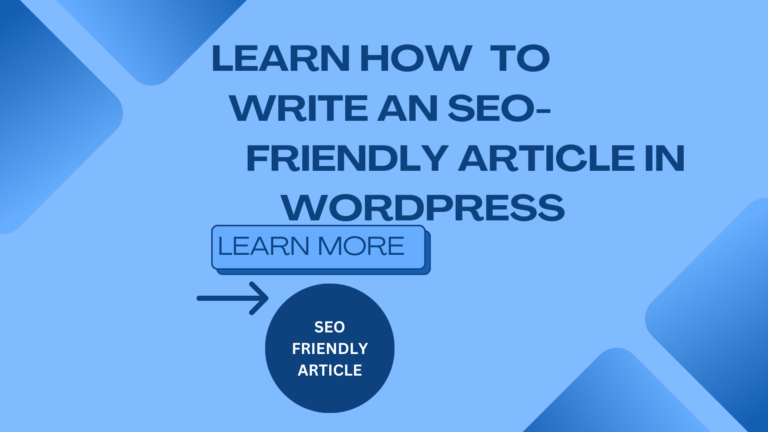How to Write an SEO-Friendly Article in WordPress in 2026?
Writing an SEO-friendly article in WordPress is essential to rank higher on search engines like Google. By following the right techniques, you can improve your website’s visibility, attract more visitors, and enhance user engagement. This guide will help you create an optimized article that performs well in search rankings.
1. Choose the Right Topic and Keywords
Before writing, it’s important to research a topic that people are searching for. Use tools like:
- Google Trends – To check trending topics.
- Google Keyword Planner, Ahrefs, SEMrush, or Ubersuggest – To find high-volume keywords.
- Google’s “People Also Ask” Section – To understand common questions.
- Competitor Research – Analyze top-ranking websites for inspiration.
Example SEO Topics:
- “How to Optimize a WordPress Blog for SEO?”
- “Best SEO Strategies for 2025”
- “Step-by-Step Guide to Writing an SEO-Optimized Blog Post”
2. Use SEO-Friendly Keywords
Selecting and using the right keywords naturally in your article helps improve SEO rankings. Focus on:
- Main Keyword – The primary keyword related to your topic.
- Long-Tail Keywords – More detailed phrases people search for.
- LSI Keywords – Related terms that give context to your article.
Tools for Keyword Research:
- Google Keyword Planner
- Ahrefs
- SEMrush
- Ubersuggest
3. Structure Your Article Properly
A well-structured article improves readability and SEO. Follow this format:
SEO-Optimized Article Format:
- Title (H1) – Catchy and includes the main keyword.
- Introduction – Engaging, with the main keyword in the first 100 words.
- Headings (H2, H3, H4) – Organize content with subheadings.
- Short Paragraphs – 2-3 sentences per paragraph.
- Bullet Points & Lists – Improves readability.
- Internal Linking – Link to related articles on your site.
- External Links – Link to high-authority sources (e.g., Wikipedia, Google).
- Images with Alt Text – Helps with SEO and accessibility.
- Conclusion – Summary with a strong Call to Action (CTA).
Example of an SEO-Optimized Title:
❌ “SEO Guide” ✅ “How to Write an SEO-Friendly Article in WordPress (Step-by-Step Guide)”
4. Optimize On-Page SEO
Once the content is ready, optimize it for SEO:
Meta Title & Meta Description
- Meta Title: 50-60 characters with the main keyword.
- Meta Description: 150-160 characters, summarizing the article engagingly.
SEO-Friendly URL
- ❌ Bad:
example.com/?p=123 - ✅ Good:
example.com/seo-friendly-wordpress-article
Optimize Images
- Use compressed images (TinyPNG).
- Add descriptive alt text.
Ensure Mobile-Friendliness
- Use a responsive WordPress theme.
Improve Page Speed
- Use caching plugins like WP Rocket or LiteSpeed Cache.
5. Build Backlinks (Off-Page SEO)
Backlinks from reputable sites improve your article’s ranking. Try:
- Guest Blogging – Write for other websites and link back to your post.
- Quora & Reddit – Answer relevant questions and include your article link.
- Social Media Sharing – Share on Facebook, Twitter, LinkedIn, and Pinterest.
- Internal Linking – Connect your article with other related blog posts.
6. Monitor Performance with Google Tools
Track your article’s performance using:
✅ Google Search Console
- Check indexing status.
- Analyze search performance.
✅ Google Analytics
- See visitor traffic sources.
- Monitor bounce rate & engagement.
Final Thoughts – Best SEO Strategy for WordPress Articles
To rank your WordPress article on Google, follow these steps:
✔ Choose a High-Search Volume Topic ✔ Use SEO-Friendly Keywords Naturally ✔ Write an Optimized and Well-Structured Article ✔ Apply On-Page SEO Techniques ✔ Build Backlinks and Share on Social Media ✔ Monitor Performance with Google Tools
For more details click here⬇️
https://www.reliablesoft.net/what-is-a-seo-friendly-website-and-why-do-you-need-one/



